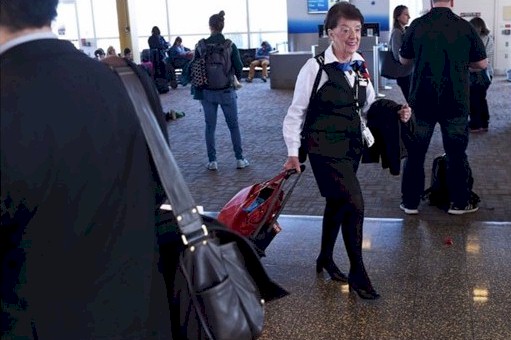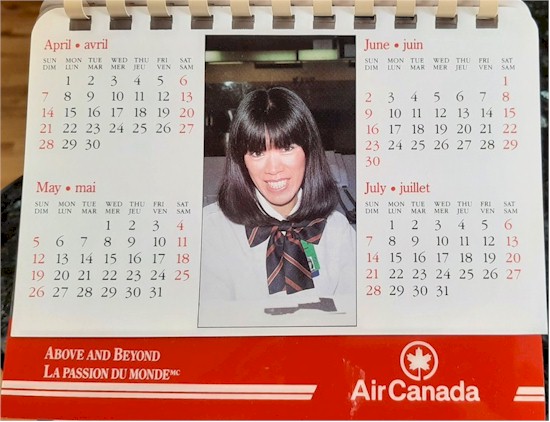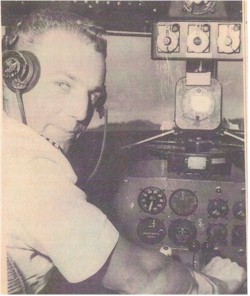|
Subscriber Shirlee Schacter sent us in an update on American Airlines flight attendant Bette Nash who will celebrate 65 years of service this Fall. Editors' Note: We have previously published stories on Ms. Nash in two previous NetLetter editions
|
|
Shirlee writes: I thought my sister, Gayle, had a record-setting career staying with Air Canada for 50 years and 6 months but this lady has her beat! Eighty-six year-old woman is longest-serving flight attendant, Guinness says. Bette Nash will celebrate 65 years in-flight this fall. Excerpt from a story by Sam Sweeney of ABC News. At 86 years old, American Airlines flight attendant Bette Nash is the oldest and longest-serving flight attendant in the world, according to Guinness World Records. Nash started flying back in 1957 and will celebrate 65 years in-flight this fall. She can choose any route she wants and for most of her career she has been loyal to the New York-Washington-Boston Shuttle. Nash prefers this route because she says it allows her to be home every night with her handicapped son who she continues to care for to this day. When she first started flying, she says passengers bought life insurance from a vending machine before boarding and the airline would check on her at home to ensure she wasn’t living with a man because flight attendants had to be single. The airline also weighed her before shifts and could suspend her if she gained too much weight, she said. “You had to be a certain height, you had to be a certain weight. It used to be horrible. You put on a few pounds and you had to keep weighing yourself, and then if you stayed that way, they would take you off the payroll,” Nash said during a flight in 2017 with ABC affiliate WJLA cameras onboard. (Click the image below to view the video) Nash started flying with Eastern Airlines and through a number of mergers, including with Donald Trump’s airline in the late 1980’s, ended up at American Airlines. In the early days, passengers paid the flight attendant when they boarded; Nash says her early flights cost $12 between New York and Washington. “We used to pass out cigarettes and matches...on the flight, after the meal service, I would go around with Kent’s and Marlboros,” she told WJLA on her 60th anniversary. Nash still attends regular flight attendant training per Federal Aviation Administration rules. |
 |
|
Subscriber Johanna Scher sent in the following: The article 'The Whispering Giants', in NetLetter #1491, brought back many memories. In 1959 my husband Eric Scher was an agent 'grade 1' in Vancouver when the CP Air trans Canada route opened. He applied for and got the position of agent grade 2 in Montreal. Getting to YUL was not that easy, as airline personnel were not allowed to travel across Canada directly, but we had to go to Mexico, stay there overnight and then take the flight to Montreal. Our daughter was 1 year old at the time and a handful, but we had a wonderful time as the CP crew had an overnight stay in Mexico as well and included us in their activities. It was wonderful to have so many friends take care of our daughter. Once in Montreal we stayed there until 1974 when we were transferred to Lima, Peru. |
|
Subscriber Erik Zuyderduyn sent in this comment to Ken Pickford's attention: Hi Ken, Regarding the article on the RCAF Comet in NetLetter #1491, could you also add a piece on the Canadian Pacific Air Lines purchase of the Comets, which never saw service. The first one met its demise in Karachi. I have the full story somewhere, but can't find it. I'm sure that you do. Stay well and keep up the good work. Erik |
|
Ken's response: Canadian Pacific Air Lines ordered two De Havilland Comet 1 aircraft in 1949 for intended use on the Honolulu-Nadi (Fiji)-Sydney portion of the Vancouver-Sydney route, some flights with a stop at Auckland. All flights would also include a fuel stop at Canton Island, a remote atoll between Honolulu and Nadi. Due to the Comet's insufficient range, the Vancouver-Honolulu sector would be operated by Douglas DC-6B propeller aircraft. The first CPA Comet (actually the second built), named Empress of Hawaii and registered CF-CUN, was lost March 3, 1953 in a takeoff accident at Karachi, Pakistan, a fuel stop on its delivery flight from London Heathrow to Sydney. All 5 CPA crew and 6 passengers were killed. The passengers were De Havilland employees. That was the first fatal accident involving a commercial jet. The circumstances were very similar to a BOAC Comet lost on takeoff from Rome about 5 months earlier, fortunately with no fatalities. The cause of both accidents, where the aircraft failed to become airborne, was determined to be a problem with the design of the wing which lost lift if the aircraft was rotated beyond a certain angle on takeoff. The wing was subsequently modified to correct that problem which was unrelated to the subsequent catastrophic Comet crashes due to structural failure that resulted in the grounding of the early Comets in April 1954. After the Karachi accident, CPA cancelled the Comet order and the other CPA Comet, CF-CUM, named Empress of Vancouver, not yet delivered, was sold to BOAC. That aircraft had been displayed in CPA livery at the Farnborough Airshow in 1952. After the Comet grounding, it was used by the British government for structural testing. The nose section survives at the De Havilland Aircraft Museum in Hertfordshire about 30 km north of London, not far from the site of the former De Havilland factory at Hatfield where all Comets were built. |
|
Editors' Note: Due to copyright we cannot show thumbnails of the following images, however, we can provide links to the original websites. Additional photos links: CF-CUM at Farnborough, September 1952 CF-CUN at Hatfield factory 1952 Two photos of same aircraft in BOAC livery, registered G-ANAV, while chartered to South African Airways for several months prior to the April 1954 grounding. Note dual BOAC/SAA markings. |
|
Neil Burton has sent us this information - Looking back at 'Subscriber Feedback', NetLetter #1488, and contributions of James Fraser and Dave Shore on CP Air. |
|
'Last Flight Out' with CP Air pilot Nick Atamanchuk.
The article reads: Last flight out. “At the controls of CPA's last flight out of Kamloops with the change-over to PWA service, was pilot Nick Atamanchuk. It was all the more fitting since Mr. Atamanachuk was born and raised in Kamloops. He was educated in Kamloops schools and graduated from Kamloops Secondary school. He started flying commercially three years ago and flew various overseas flights before being assigned to the Interior run. Mr Atamanchuk lives in Prince George.” Neil Burton
|
|
It was with great interest that I read the 'Above and Beyond' story capturing employee smiles in NetLetter #1491. There was no other communication with him. Some time later an AC manager mentioned he saw a calendar with my photo in it. This was a BIG surprise to me; here it is. Regards, Eddi Palsgraaf, |
 |

